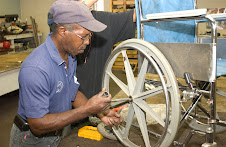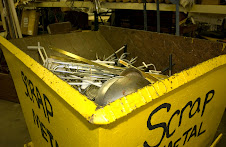Why is the reuse of assistive technology a great idea?
1. It provides devices to people who are uninsured or underinsured.
Wheelchairs in closets, text-to-speech programs on the shelf, walkers piled high at the local salvage yard, bariatric devices in the garage after the original user lost the desired 250 pounds, old prescription eyeglasses, the computer abandoned for a newer model, the cell phone that isn't the latest and greatest. These devices are the reality of our daily lives -- unused assistive technology that could help someone participate in the activities of daily life, whether work, learning, play or family. Many people do not have insurance coverage or money to acquire the AT they need.
2. Even those who have access to funding may need an interim solution.
How long might a person wait for private insurance, Medicare or Medicaid to approve and provide a needed AT device? Wouldn't it be great to borrow a device from a reuse program until the permanent device becomes available?
3. Reuse is a "green" idea.
Reusing assistive technology keeps devices out of landfills. That saves taxpayer money and ultimately reduces the impact on the environment. It reduces the "carbon footprint" of the industries that need to keep making more AT devices. It saves resources for future use.
4. Reuse can reduce healthcare costs.
Reusing those lightly-used devices can keep down the cost of healthcare provided through taxpayer dollars. This is not to argue that people should not get new devices, but that there is a role for reuse in the process. Many AT devices are needed only for a short period of time to assist in recovery from injury or illness.
5. Reusable devices can be a blessing in disasters.
Sometimes disasters require evacuation so quickly that an invidual cannot bring the equipment. Sometimes it is damaged in a disaster. Sometimes disasters cause injuries that result in the need for assistive technology for more people. That can be true here or elsewhere.
Friends of Disabled Adults and Children (Stone Mountain, Georgia) collaborated with Port Light Strategies (South Carolina) to fill the wish lists of people running field clinics in Haiti after the earthquake of 2010. Instead of random shipments, workers in Haiti identified the durable medical equipment and supplies needed and FODAC worked with Port Light volunteers to pack refurbished equipment to meet those needs.
Monday, February 14, 2011
Five Quick Arguments for AT Reuse
Labels: program improvement, quality indicators
AT reuse,
disaster response,
FODAC,
Port Light,
uninsured individuals
AT Reuse: Loving the Idea
At the end of January, Pass It On Center staff members and some willing contributors from AT reuse programs travelled to Orlando for the Assistive Technology Industry Association (ATIA )Conference. ATIA is a twice-yearly conference (Orlando in January and Chicago in October) where the makers of technology for those with functional needs come together with the professionals who provide the services (occupational therapists, physical therapist, rehabilitation professional, speech-language pathologists, special education teachers, etc.). It's an amazing experience, and ATIA provides access to the Exhibit Hall without charge. That's great because it attracts visitors from the community.
In addition to an all-day Pre-Conference, the Pass It On Center presented a strand of sessions on Reuse. Participants at the Pre-Conference included Dr. Stanley Pomarantz of Parkland Hospital in Dallas, who is planning a new reuse program to provide durable medical equipment for the uninsured, and David Banes, Deputy Director of Mada, Qatar's Assistive Technology Center. Mada is a nonprofit, state-of-the-art center designed to connect people with functional needs with information and communications technology.
Both Dr. Pomarantz and Mr. Banes come from places that we associate with affluence, but Dr. Pomarantz reports that 33 percent of the residents of Dallas County under the age of 65 have no medical coverage. That is nearly double the national average. He estimates that 25,000 to 50,000 individuals per year are in need of free or low-cost durable medical equipment in his home county. The need is obvious, but the challenge lies in gaining financial support.
As we sat in our booth in the Exhibit Hall, we had visitors of all kinds stop to ask what we do. Most thought AT reuse was a great idea. Many special education teachers were interested in how school district boundaries could be overcome to share AT. We were happy to tell them about programs in New England that are beginning to do just that. We save college professors and students from occupational therapy programs who were interested in reuse and in becoming familiar with reuse. We would like every person who loved the idea of reuse to become involved in a local effort -- as a donor, a volunteer or a supporter in some fashion. We referred dozens of people to our map and database of AT reuse locations. Just click on the Reuse Locations tab at http://www.passitoncenter.org to find the reuse location nearest to you. If you know about a reuse program that is not listed, please ask them to create a profile. We want to see the list grow -- and we're looking forward to the day when there will be a listing for that program in Dallas that Dr. Pomarantz is working to develop now.
In addition to an all-day Pre-Conference, the Pass It On Center presented a strand of sessions on Reuse. Participants at the Pre-Conference included Dr. Stanley Pomarantz of Parkland Hospital in Dallas, who is planning a new reuse program to provide durable medical equipment for the uninsured, and David Banes, Deputy Director of Mada, Qatar's Assistive Technology Center. Mada is a nonprofit, state-of-the-art center designed to connect people with functional needs with information and communications technology.
Both Dr. Pomarantz and Mr. Banes come from places that we associate with affluence, but Dr. Pomarantz reports that 33 percent of the residents of Dallas County under the age of 65 have no medical coverage. That is nearly double the national average. He estimates that 25,000 to 50,000 individuals per year are in need of free or low-cost durable medical equipment in his home county. The need is obvious, but the challenge lies in gaining financial support.
As we sat in our booth in the Exhibit Hall, we had visitors of all kinds stop to ask what we do. Most thought AT reuse was a great idea. Many special education teachers were interested in how school district boundaries could be overcome to share AT. We were happy to tell them about programs in New England that are beginning to do just that. We save college professors and students from occupational therapy programs who were interested in reuse and in becoming familiar with reuse. We would like every person who loved the idea of reuse to become involved in a local effort -- as a donor, a volunteer or a supporter in some fashion. We referred dozens of people to our map and database of AT reuse locations. Just click on the Reuse Locations tab at http://www.passitoncenter.org to find the reuse location nearest to you. If you know about a reuse program that is not listed, please ask them to create a profile. We want to see the list grow -- and we're looking forward to the day when there will be a listing for that program in Dallas that Dr. Pomarantz is working to develop now.
Labels: program improvement, quality indicators
AT reuse,
ATIA,
Dallas,
new reuse programs
Subscribe to:
Posts (Atom)


